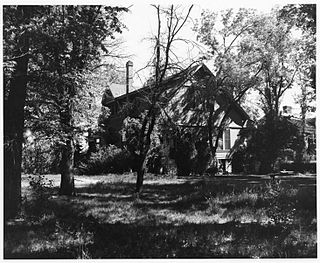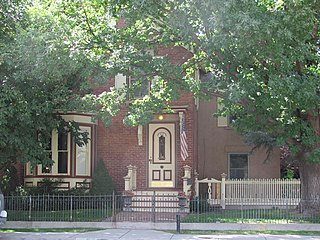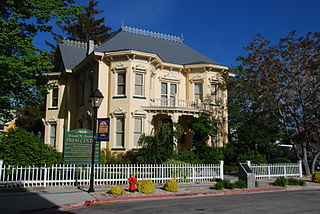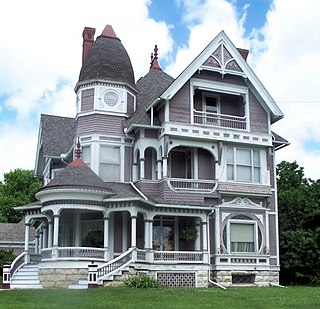
The Nevada State Capitol is the capitol building of the U.S. state of Nevada located in the state capital of Carson City at 101 North Carson Street. The building was constructed in the Neoclassical Italianate style between 1869 and 1871. It is listed in the National Register of Historic Places. It is also Nevada Historical Marker number 25.

The Francis G. Newlands Home is a historic house at 7 Elm Court in Reno, Nevada, United States. Built in 1890, it is the former mansion of United States Senator Francis G. Newlands (1846-1917), a driving force in passage of the 1902 Newlands Reclamation Act. It was declared a National Historic Landmark in 1963 and listed on the National Register of Historic Places in 1966. The house is privately owned and is not open to the public.

The Thomas C. Carson House is a historic building located in Iowa City, Iowa, United States. It is currently in use as the sorority house of the University of Iowa chapter of Alpha Phi, and is thus also known as the Carson-Alpha Phi House.

The Carson City Civic Auditorium, at 813 N. Carson St. in Carson City, Nevada, was designed by architect Lehman A. Ferris and was built during 1938–39. It was funded by a municipal bond and by the Public Works Administration. Also known simply as Municipal Auditorium, it was listed on the National Register of Historic Places in 1990. Since 1994, the building has served as the location for the Children's Museum of Northern Nevada.

The Brougher Mansion, at 204 W. Spear St. in Carson City, Nevada, is a historic Queen Anne-style house that was built in 1903–1904. Also known as the Bath Mansion, it was listed on the National Register of Historic Places in 1904.

The Dr. William Henry Cavell House, at 402 W. Robinson St. in Carson City, Nevada, United States, was built in 1907. It is one of two Carson City houses constructed from the same plans, designed by Oakland, California architect John Conant. It includes Shingle Style and Colonial Revival architectural elements. It was listed on the National Register of Historic Places in 1987. It was deemed significant for association with dentist Dr. William Henry Cavell, and was originally a wedding gift from him to Ida Platt Cavell. It stayed in the Cavell family until 1951.

The George L. Sanford House, at 405 N. Roop St. in Carson City, Nevada, United States, was built in c.1910. It includes Bungalow/craftsman, Stick/Eastlake, and Second Empire architecture. It was listed on the National Register of Historic Places in 1994; the listing included two contributing buildings.

The Leport–Toupin House, at 503 E. Telegraph St. in Carson City, Nevada, is a historic simplified-Second Empire-style house that was built in 1879. It was converted to a pre-school in 1969. Also known as the Hawkins House, it was listed on the National Register of Historic Places in 1985.

The King–McBride Mansion, at 26-28 S. Howard St. in Virginia City, Nevada, is a historic Italianate-style house that was built in 1876, not long after the "Great Fire" in October, 1875. Also known as King House, it was listed on the National Register of Historic Places in 1998.

The Arendt Jensen House, at 1431 Ezell St. in Gardnerville, Nevada, is a historic foursquare house—in this case termed a "Denver Square" form—that was built in 1910. It was a home of Danish immigrant Arendt Jensen, a merchant who became prominent in Gardnersville. Also known as the Reid Mansion, it includes Colonial Revival-style ornamentation. It was listed on the National Register of Historic Places in 1989; the listing included two contributing buildings: the second is an accompanying garage.

The Carson Brewing Company, at 102 S. Division St. in Carson City, Nevada, was built in 1864. Also known as the Carson City Nevada Appeal Building, it was listed on the National Register of Historic Places in 1978. It was originally a brewery and bar.

The William Spence House, at 308 S. Thompson St. in Carson City, Nevada, was built in 1875. It includes Greek Revival architecture. It was listed on the National Register of Historic Places in 1985.

The Orion Clemens House, also known as Mark Twain's House, is a two-story Late Victorian house located at 502 N. Division St. in Carson City, the capital of the U.S. state of Nevada. It was listed on the National Register of Historic Places in 1979.

The David Smaill House, at 313 W. Ann St. in Carson City, Nevada, was built in c.1876. Also known as the Smaill House, it was listed on the National Register of Historic Places in 1985.

The Abraham Curry House, at 406 N. Nevada St. in Carson City, Nevada, was built c. 1871. It was listed on the National Register of Historic Places in 1987. It is a one-story masonry building that was home for Carson City founder Abraham Curry, who was first Superintendent of the United States Mint in Carson City.

The Dat So La Lee House, which is located at 331 W. Proctor St. in Carson City, Nevada, is a historic house that is listed on the National Register of Historic Places. It was a home of Dat So La Lee, a woman who also was known as Louisa Keyser, who was a well-known Washoe Indian basket weaver. The house, also known as the Louisa Keyser House, was listed on the National Register in 1994.

The Foreman–Roberts House, formerly the James D. Roberts House and now also known as the Foreman–Roberts House Museum, is a historic house and museum located at 1217 N. Carson St. in Carson City, Nevada. The house was built in 1859 and was moved to the present location in 1873. Known also as the Thurman Roberts House for the last member of the Roberts family, it is listed on the National Register of Historic Places. It is the headquarters of the Carson City Historical Society and is open to the public by appointment and for special events.

The Gov. James W. Nye Mansion, at 108 N. Minnesota St. in Carson City, Nevada, United States, was built in 1860. It has also been known as St. Teresa's Rectory. It was a home of U.S. senator William M. Stewart and of Nevada territory governor James W. Nye.

The Rinckel Mansion is a historic house in Carson City, Nevada, United States, that is listed on the National Register of Historic Places (NRHP).

The James A. Beck House, also known as the Sloca House, is a historic residence located in Fairfield, Iowa, United States. Beck was a Fairfield native who owned a grocery business, before starting a profitable career as a hotelier. He had this Queen Anne house built in 1896. It is based on a pattern designed by the George F. Barber & Co. of Knoxville, Tennessee. It is similar to the Linsay House in Iowa City, which was built closer to the original pattern. The 2½-story frame house follows an irregular plan and it is built on a stone foundation. It features a polygonal turret that rises from the second floor over the wrap-around porch. The porch itself features a circular pavilion that is capped by a flattened conical roof. A two-story carriage house is located behind the main house. It dates from 1875 when the previous house on this property was built, and was renovated to reflect the Queen Anne house. The Beck House was listed on the National Register of Historic Places in 1978.






















